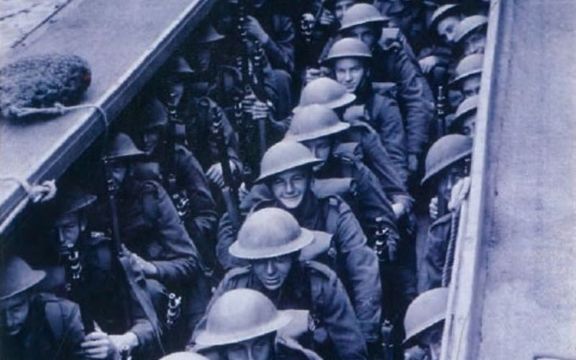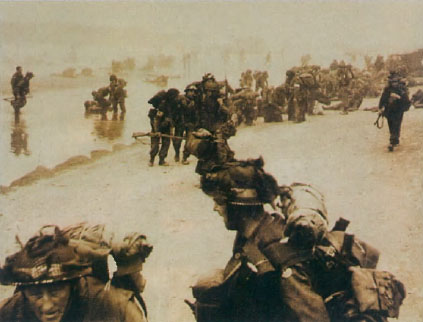
Ranks of Royal Marines train aboard a landing craft in preparation for the D-Day assault.[
To the soldiers who stood for hours in transport ships, barely able to see the coming coast of France from over the edge of the ship, D-Day was not about a master plan executed perfectly; it was about walking straight into hell and hopefully finding a way back out.
Ken Garrett of the Royal Canadian Navy recalled hearing for the first time about his own place in the operation: ‘“Tomorrow is D-Day. There will be no leave tonight and I have the great honour to advise you we have been chosen to be in the spearhead of the invasion. We will be at the point of the spear.’ This instant, we all had the undesirable feeling that tomorrow we might all be dead. My stomach felt like a bunch of feathers. It was the most awful feeling I ever had.”
The news of the impending attack changed the lives of many soldiers. Their first priority became one of survival rather than of killing. Likewise, the work to set the stage for D-Day had also become inverted. General Percy Hobart of the British 79th Armoured Division informed his men that their job would be to clear the tangle of mines and obstacles littering the beaches: “You have heard of the Lord Mares show, and you know about the people who come afterwards to clear up the mess. Well, your job is going to be the very opposite. You’re going in front to clear up the mess.”
And so they went.
“Rank after relentless rank,” as author Cornelius Ryan describes in his well-known book, The Longest Day. “Ten lanes wide, twenty miles across, five thousand ships of every description. There were endless columns of shallow-draft landing ships—great wallowing vessels, some of them almost 350 feet long…. Ahead of the convoys were processions of minesweepers, Coast Guard cutters, buoy-layers and motor launches. And surrounding this fantastic cavalcade of ships packed with men, guns, tanks, motor vehicles and supplies…was a formidable array of 702 warships.”
The landing on the beaches of Normandy was far from glorious. Recalling his own bouts of seasickness, Bob Slaughter of the U.S. 116th Infantry Regiment described his own inglorious approach to the coast of France: “It was probably in the 40s and the wind was blowing and we were soaking wet and I was just shivering. And I really got sick and I started to vomiting in my helmet…. Throw it out and wash the helmet and vomit some more and that’s the way we went in.”
Another soldier recalled expecting a “very hot reception from the shore batteries” as “a big full moon was smiling down between the scudding clouds…. About 0500 hours,” he remembered, “the eastern sky began to brighten into daylight. First thing we knew, there was the coast of Normandy right in front of us, about ten miles away.”

On Sword Beach, British troops prepare to advance inland. via MARY EVANS PICTURE LIBRARY
However, as the beaches slowly came into view, and as the ramps came thundering open, the soldiers’ focus turned from their own bodies to the oncoming rain of German fire. Some fell nearly immediately, and those who looked on had the images branded on their consciousnesses. “I guess a wave had caused the landing craft to surge forward,” a veteran later recalled, “and the ramp just smashed him in and killed him. I do remember it was a terrible sight and a shock to everybody to see a healthy young man one minute and the next minute he’s smashed to smithereens, you couldn’t tell what he was.”
“WE COULDN’T RETREAT BECAUSE THERE WAS NOWHERE TO GO BACK THERE, SO THE ONLY OPTION WAS STRAIGHT AHEAD.”
Those who made it to the beach sensed a feeling of impending doom as they felt they “were in for a nasty surprise in the form of some new German secret weapon.” A secret weapon never revealed itself, but the desperation of their fellow soldiers did: “from then on it was screams and hollering and people drowning and getting hit and fear…. It was bedlam, chaos, and it took a while to get it all sorted out and under control.” As order began to emerge, though, it became evident that “the Germans seemed incapable of opposing the landing,” despite having the weather in their favour.
Still, the defenders inflicted heavy Allied casualties. One Allied soldier told how two of his comrades lost their lives on the beach: “The first person I saw get wounded was a guy trying to run across the beach. He was staggering, he looked like he had a lot of baggage and he was lumbering across, about 25 yards away from me, and he got shot and he went down in a runnel of water. I watched the water turn red. And one of our medics went over to help him and they shot the medic. I wanted to help them but I knew I’d get shot if I did. Within three or four minutes both of them died. But we knew we had to go; we didn’t have any choice. We couldn’t retreat because there was nowhere to go back there, so the only option was straight ahead.”
Another soldier aboard a casualty craft noted that “These casualties made us realize how bitter the fighting was for the men on the beaches.”
It was not only horrific for the invaders. Among the dead during D-Day and the subsequent liberation of France, nearly 20,000 French civilians were killed due to Allied bombing. It is therefore understandable that French civilian Mile Genget would claim that after being awakened by a distant bombardment, “everything in the house—doors, windows, and everything in the loft seemed to be dancing. We were not feeling very brave!”
EVEN AS THE CASUALTIES CONTINUED TO climb, General Eisenhower’s “Great Crusade” ground relentlessly forward. “Mighty bulldozers were ploughing up the masses of shore obstacles, racing against the incoming tide. Sappers were disposing of land mines. The German pillboxes and strong points which had withstood the bombardment were subjecting the shoreline to incessant fire. Buildings were ablaze, and also a few landing craft. Overhead the Spitfires and Thunderbolts roared defiance to the Luftwaffe.”
Following their ultimate victory in Europe, the Allies’ task shifted to rebuilding. But although the physical traces of war would eventually fade from the streets of London, Paris, and Berlin, the memories of the men who walked straight into hell on 6th June 1944—and somehow found their way out—remain. These memories stand testament to the countless sacrifices made on D-Day.
* Originally published in July 2016.





Comments